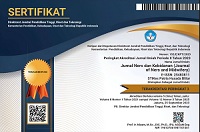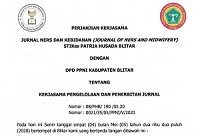Relationship Between the Frequency of Eating Snack Food and Incidence of Stunting
DOI:
https://doi.org/10.26699/jnk.v12i2.ART.p124-132Keywords:
Frequency of Snack Food Consumption, StuntingAbstract
Failure to thrive among toddlers results in stunting. One of the contributing factors is not fulfilling nutritional needs. Toddlers prefer to eat snack food with low nutritional content and the sugar content makes children feel full, reducing the portion of food in the main meal schedule that contains balanced nutritional value. The purpose of this study was to determine the relationship between the frequency of consuming snack food and the incidence of stunting. The method in this study used observations with a cross-sectional design. The Population was 232 people, with a sample of 70 mothers of stunted toddlers selected through the Simple Random Sampling technique. The instrument in this study used a questionnaire and was analyzed with the Spearman Rank test with the results (ρ = 0,000 < 0.05) between the frequency of consuming snack food and the incidence of stunting. This study showed a relationship between the frequency of consuming snack food and the incidence of stunting toddlers who consume snack food too often will cause stunting in toddlers. Based on the results, it is recommended that snack foods be given two hours before main meals to help address this issue.
References
Aini, N. (2019). Analisis Tingkat Konsumsi Zat Gizi terhadap Gizi Kurang Balita di Puskesmas Jelbuk Kabupaten Jember. Health Information : Jurnal Penelitian, 11(2), 126–132. https://doi.org/10.36990/hijp.v11i2.140
Amalika, L. S., Mulyaningsih, H., & Purwanto, E. (2023). Eksplorasi Pola Pemberian Makan Balita Stunting dan Balita Non Stunting berdasarkan Perspektif Sosio-kultural di Desa Legung Barat. Jurnal Ilmiah Ilmu Sosial, 9(2), 209–220. https://doi.org/10.23887/jiis.v9i2.71402
Andres, A., Giovannucci, E., Fisher, O., Palacios, C., Raynor, H. A., Stanford, C., Gardner, C. D., & Hoelscher, D. M. (2025). Frequency of Meals and / or Snacking and Energy Intake : A Systematic Review. https://doi.org/10.52570/nesr.dgac2025.sr10
Anugrahaeni, H. A., Nugraheni, W. T., & Ningsih, W. T. (2022). Hubungan Tingkat Pendidikan dengan Pengetahuan Orang Tua tentang Stunting pada Balita di Wilayah Kerja Puskesmas Semanding. Jurnal Keperawatan Widya Gantari Indonesia, 6(1), 64–72. https://doi.org/10.52020/jkwgi.v6i1.3459
Aryani, N. A., & Wahyono, B. (2020). Program Pemberian Makanan Tambahan Pemulihan (PMT-P) untuk Penderita Balita Gizi Buruk. Higeia Journal of Public Health Research And Development, 4(3), 460–470. https://doi.org/10.15294/higeia/v4i3/31955
Basuki, S. R., Sastramihardja, H. S., & Setiowulan, W. (2021). Hubungan Pola Konsumsi Kudapan dengan Stunting pada Anak Kelas 1-2 SDN 036 Ujungberung Kota Bandung. Sari Pediatri, 23(2), 121. https://doi.org/10.14238/sp23.2.2021.121-8
Cooke, carlton B. (2024). 9. Obesity Reviews - 2024 - Cooke - The effect of discretionary snack consumption on overall energy intake weight status and.pdf. https://doi.org/10.1111/obr.13693
Damanik, S. M., Wanda, D., & Hayati, H. (2020). Feeding practices for toddlers with stunting in Jakarta: A case study. Pediatric Reports, 12. https://doi.org/10.4081/pr.2020.8695
Elisanti, A. D., Jayanti, R. D., Amareta, D. I., Ardianto, E. T., & Wikurendra, E. A. (2023). Macronutrient intake in stunted and non-stunted toddlers in Jember, Indonesia. Journal of Public Health Research, 12(3). https://doi.org/10.1177/22799036231197178
Gage, R., Girling-Butcher, M., Joe, E., Smith, M., Ni Mhurchu, C., McKerchar, C., Puloka, V., McLean, R., & Signal, L. (2021). The frequency and context of snacking among children: An objective analysis using wearable cameras. Nutrients, 13(1), 1–16. https://doi.org/10.3390/nu13010103
Green, M., Hadihardjono, D. N., Pries, A. M., Izwardy, D., Zehner, E., & Huffman, S. L. (2019). High proportions of children under 3 years of age consume commercially produced snack foods and sugar-sweetened beverages in Bandung City, Indonesia. Maternal and Child Nutrition, 15(S4), 1–14. https://doi.org/10.1111/mcn.12764
Hess, J. M. (2022). Understanding the link between frequency of eating and cardiometabolic health outcomes in Americans who “snack”*. JDS Communications, 3(6), 462–466. https://doi.org/10.3168/jdsc.2022-0289
Hess, J. M., Jonnalagadda, S. S., & Slavin, J. L. (2016). What is a snack, why do we snack, and how can we choose better snacks? A review of the definitions of snacking, motivations to snack, contributions to dietary intake, and recommendations for improvement. Advances in Nutrition, 7(3), 466–475. https://doi.org/10.3945/an.115.009571
Indahsari, N. K., Herliani, O., & Masfufatun, M. (2023). The relationship between food quantity and diversity with stunting incidence in Indonesia. Healthcare in Low-Resource Settings, 11(2), 163–167. https://doi.org/10.4081/hls.2023.11773
Kemenkes. (2014). Peraturan Menteri Kesehatan Republik Indonesia Nomor 41 Tahun 2014. 1–96.
Kemenkes RI. (2018). Hasil Riset Kesehatan Dasar Tahun 2018. Kementerian Kesehatan RI, 53(9), 1689–1699.
Kemenkes RI. (2020). Peraturan Menteri Kesehatan Republik Indonesia Nomor 2 Tahun 2020 Tentang Standar Antropometri Anak. 21(1), 1–9.
Kemenkes RI. (2022). Petunjuk Teknis Pemberian Makanan Tambahan (PMT) Berbahan Pangan Lokal untuk Balita dan Ibu Hamil. Kemenkes, June, 78–81.
Kemenkes RI. (2023). Hasil Survei Status Gizi Indonesia (SSGI) 2022. Kemenkes, 1–7.
Kumalasari, D., & Wulandari, U. R. (2024). Kebiasaan Makan pada Balita Stunting di Kecamatan Grogol Kabupaten Kediri. JURNAL KESEHATAN PERINTIS (Perintis’s Health Journal), 11(1), 28–34. https://doi.org/10.33653/jkp.v11i1.1075
Kurniawan, Y. S., Priyangga, K. T. A., Krisbiantoro, P. A., & Imawan, A. C. (2021). Connection Habit Snacks and Consumption Food with the Nutritional Status of Children at Elementary School Inpres 08 Mamboro. Journal of Multidiciplinary Applied Natural Science, 1(1), 1–12.
Manalu, K. N., Meliyani, H., Nai, E., & Pujiastuti, V. I. (2024). Frekuensi konsumsi makanan instan dan stunting pada anak usia 6-23 bulan. 21(2), 60–69. https://doi.org/10.22146/ijcn.85169
Matondang, R. J. A., & Yuliaty, M. (2024). Unhealthy Snacking Habits are Prevalent Among Elementary School Students. Jurnal Becoss, 6(1), 13–21. https://doi.org/10.21512/becossjournal.v6i1.10828
Mireault, A., Mann, L., Blotnicky, K., & Rossiter, M. D. (2023). Evaluation of snacks consumed by young children in child care and home settings. International Journal of Child Care and Education Policy, 17(1), 1–14. https://doi.org/10.1186/s40723-023-00106-7
Nachvak, S. M., Sadeghi, O., Moradi, S., Esmailzadeh, A., & Mostafai, R. (2020). Food groups intake in relation to stunting among exceptional children. BMC Pediatrics, 20(1), 1–8. https://doi.org/10.1186/s12887-020-02291-7
Nadimin, N., Theresia Dewi, K. B., Salam, A., & Adam, A. (2021). Local snacks and virtual nutrition counseling services increasing growth of stunting children. Open Access Macedonian Journal of Medical Sciences, 9(B), 331–336. https://doi.org/10.3889/oamjms.2021.5875
Nurkomala, S., Nuryanto, N., & Panunggal, B. (2018). Praktik Pemberian Mpasi (Makanan Pendamping Air Susu Ibu) Pada Anak Stunting Dan Tidak Stunting Usia 6-24 Bulan. Journal of Nutrition College, 7(2), 45. https://doi.org/10.14710/jnc.v7i2.20822
Pries, A. M., Rehman, A. M., Filteau, S., Sharma, N., Upadhyay, A., & Ferguson, E. L. (2019). Unhealthy Snack Food and Beverage Consumption Is Associated with Lower Dietary Adequacy and Length-for-Age z-Scores among 12-23-Month-Olds in Kathmandu Valley, Nepal. Journal of Nutrition, 149(10), 1843–1851. https://doi.org/10.1093/jn/nxz140
Purwestri, R. C., Barati, Z., Wirawan, N. N., Fahmi, I., Lauvai, J., & Scherbaum, V. (2018). What explains stunting among children living in a rice surplus area in Central Java, Indonesia? Diversity and Change in Food Wellbeing, 137–151. https://doi.org/10.3920/978-90-8686-864-3_7
Putri, N. M., Oktavira, A. I., Putri, S. T., & Fevria, R. (2022). Peran Zat Gizi untuk Mencegah Terjadinya Stunting pada Anak The Role of Nutrition Substances to Prevent Stunting on Children. Prosding Seminar Nasional Biologi, 2(2), 849–854. https://doi.org/10.24036/prosemnasbio/vol2/512
Rahmaniah. (2020). Hubungan Frekuensi Pemberian Makanan dan Riwayat ASI Eksklusif Dengan Kejadian Stunting pada Baduta di Desa Parappe. Journal of Health Education and Literacy, 2(2), 81–86. https://doi.org/10.31605/j-healt.v2i2.617
Rahmi, S. (2018). Cara Memilih Makanan Jajanan Sehat Dan Efek Negatif Yang Ditimbulkan Apabila Mengkonsumsi Makanan Jajanan Yang Tidak Sehat Bagi Anak-Anak Sekolah. Prosiding Seminar Nasional Hasil Pengabdian 2018 CARA, 260–265. https://e-prosiding.umnaw.ac.id/index.php/pengabdian/article/view/92
Risnah, Huriati, Hadrayani, E., Arbianingsih, Muthahharah, Nurhidayah, & Purwanti, S. (2024). Irregular dietary habits as a predictor of stunting occurrence among children under 5 years of age: a literature review. Frontiers of Nursing, 11(1), 17–22. https://doi.org/10.2478/FON-2024-0002
Taslim, N. A., Farradisya, S., Gunawan, W. Ben, Alfatihah, A., Barus, R. I. B., Ratri, L. K., Arnamalia, A., Barazani, H., Samtiya, M., Mayulu, N., Kim, B., Hardinsyah, H., Surya, E., & Nurkolis, F. (2023). The interlink between chrono-nutrition and stunting: current insights and future perspectives. Frontiers in Nutrition, 10(December). https://doi.org/10.3389/fnut.2023.1303969
Tebi, Dahlia, Wello, E. A., Safei, I., Juniarty, S., & Kadir, A. (2021). Literature Review Faktor-Faktor yang Mempengaruhi Terjadinya Stunting pada Anak Balita. Fakumi Medical Journal, 1(3), 234–240. https://doi.org/10.33096/fmj.v1i3.70
Vatanparast, H., Islam, N., Masoodi, H., Shafiee, M., Patil, R. P., Smith, J., & Whiting, S. J. (2020). Time, location and frequency of snack consumption in different age groups of Canadians. Nutrition Journal, 19(1), 1–9. https://doi.org/10.1186/s12937-020-00600-5
Vatanparast, H., Islam, N., Patil, R. P., Shafiee, M., Smith, J., & Whiting, S. (2019). Snack consumption patterns among canadians. Nutrients, 11(5), 1–12. https://doi.org/10.3390/nu11051152
Willyanto, R., & Ramadhani, M. (2023). Hubungan Pendidikan Ibu Terhadap Kejadian Stunting pada Anak Bayi Lima Tahun; Sistematik Review. Journal of Health Management, Administration and Public Health Policies (HealthMAPs), 1(1), 1–7. https://doi.org/10.52060/healthmaps.v1i1.1135

Downloads
Published
How to Cite
Issue
Section
License
Copyright (c) 2025 Jurnal Ners dan Kebidanan (Journal of Ners and Midwifery)

This work is licensed under a Creative Commons Attribution-ShareAlike 4.0 International License.


 Poltekkes Kemenkes Malang - Indonesia
Poltekkes Kemenkes Malang - Indonesia Google Scholar
Google Scholar Scopus
Scopus Sinta
Sinta ORCID
ORCID





